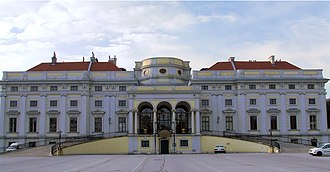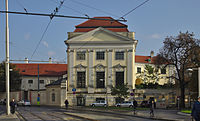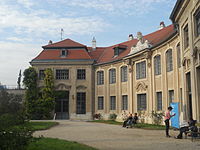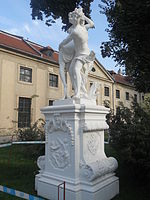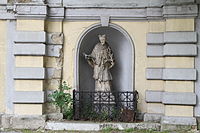Schwarzenberg Palace (Schwarzenbergplatz)
The Schwarzenberg Palace is a palace in the 3rd Vienna district highway . It is one of the most important baroque garden palaces in Vienna.
history
The palace was commissioned in 1697 by the Obersthofmarschall Heinrich Franz Graf von Mansfeld and Prince von Fondi from Johann Lukas von Hildebrandt as Palais Mansfeld-Fondi . The shell was completed in 1704.
The summer palace with its magnificent garden is located directly next to the Belvedere Palace , which was also built by Johann Lukas von Hildebrandt for Prince Eugene of Savoy at the time . Prince von Mansfeld died while the Mansfeld-Fondi Palace was being built. The unfinished property was finally bought in 1716 by Adam Franz Karl Fürst von Schwarzenberg . The prince commissioned the architects Johann Bernhard Fischer von Erlach and Joseph Emanuel Fischer von Erlach to complete the building . The dome fresco was created by Daniel Gran in 1726. The final completion took place in 1728. 1751/52 the engineer Andrea Altomonte added the riding school to the east (1927-29 revised by Karl Wilhelm Schmidt ).
During the Second World War , the Schwarzenberg Palace was badly damaged by bombing . However, it was completely rebuilt after the end of the war.
In 1982-84 the main building was renovated by the architect Hermann Czech .
Gardens (Schwarzenberggarten)
The garden was created as an Italian - French baroque terrace garden from 1697, and was designed by Hildebrandt and the Erlachs. It looked like the adjoining Belvedere garden, which was the same as the contemporary and garden designer , but - unlike this one - only the basic features have been preserved. In addition to the round fountain and central axis, parts of the garden inventory have remained , such as a group of raptus and four seasons by Lorenzo Matielli (after 1712), garden vases by JB v. Erlach, and others. JE v. Erlach's fire machine for running the garden games was considered the most important technical attraction in Vienna in the 18th century.
The small park around the Hochstrahlbrunnen in front of the palace was created in 1873 on an area that was not originally part of the palace, on the occasion of the completion of the first Viennese high spring pipeline. Like the palace, the complex suffered severe damage during the Second World War and was revitalized as a park with French elements over the main axes in the post-war period . There are now beautiful trees.
Despite the overhaul, the garden is one of the most important garden architectural monuments in Austria and is under monument protection ( No. 54 in the appendix to Section 1, Paragraph 12 of the DMSG and in the list of monuments as a whole ). A sequoia tree ( Sequoiadendron giganteum ; NDM No. 506 , 1959) is designated as a natural monument .
Todays use
The palace is still owned by the Schwarzenberg family , namely their family foundation. In a side wing, the palace houses the former riding school on Prinz-Eugen-Straße, the Swiss embassy and the Swiss consular department.
Until January 2006 the palace was partly used as a 5- star hotel and as a restaurant . Since August 2006, parts of the property including the park can be used for events.
In 2007 the Schwarzenberg Family Foundation leased the property to a Volksbank subsidiary for 60 years ; Mohamed Bin Issa Al Jaber held the right of use . According to the operator, the plan was to convert the palace into a "6-star deluxe hotel". The opening should take place in 2011, but the renovation did not take place. In February 2011 it became known that the project was in danger of failing if Al Jaber did not provide 20 million euros for it by the end of March. Since the expected payment was not made, the contract with Al Jabers group of companies was terminated by the Volksbankengruppe on April 4, 2011. As a result, the contract between the Volksbanken Group and the Schwarzenberg Family Foundation was also terminated.
In consultation with the Schwarzenberg'schen Family Foundation, a casino company from Baden im Aargau , Switzerland, took part in the tender for new casino licenses in Vienna in the summer of 2013: The Grand Casino Wien in the Palais is to include two casinos and a restaurant. The Schwarzenberg'sche Family Foundation announced that it would make the park of the Palais publicly accessible if the casino license was granted here. On June 27, 2014, the consortium was awarded the casino license.
- gallery
Niche with a statue of Nepomuk facing Rennweg
See also
- Palais Schwarzenberg for other buildings of the same name by the Schwarzenberg family
Web links
- Entry via the Schwarzenberg summer palace on Burgen-Austria
- Schwarzenberg Palace , Planet Vienna
- Karl Lind: The princely Schwarzenberg summer palace in Vienna. In: Allgemeine Bauzeitung , year 1882, XLVII. Volume, p. 104 f. (Text). (Online at ANNO ). .
- The princely Schwarzenberg summer palace in Vienna. In: Allgemeine Bauzeitung , year 1882, XLVII. Volume, p. Plate 74 ff. (Plans). (Online at ANNO ). .
- Matthias Cremer: Inside Palais Schwarzenberg. derStandard.at, December 3, 2013, accessed on December 3, 2013 (interior views).
Individual evidence
- ^ Karl Wilhelm Schmidt , architektenlexikon.at.
- ↑ Weblink Burgen-Austria
- ^ A b Eva Berger: Historical Gardens of Austria: Gardens and parks from the Renaissance to around 1930 . tape 3 Vienna . Böhlau, Vienna 2004, ISBN 978-3-205-99353-7 , Vienna, Palaisgarten, Gartenpalais Schwarzenberg (Mansfeld-Fondi Garden Palace) , p. 114 ff . ( limited preview in Google Book search).
- ^ Salomon Kleiner: Vienna, Belvedere and Schwarzenberg Gardens, ground floor plan. 1731/38 (?) Tracing, 1850–1894; Albertina, architecture collection, Hasenauer estate ( Kulturpool.at , with illustration).
- ↑ a b cf. in addition : DnD Landschaftsplanung ZT KG: Potential analysis open space Schwarzenberggarten. Vienna, 2004 (pdf, dnd.at).
-
↑ Sheikh Al Jaber's Vienna Palais project is going differently than planned. ( Memento of February 14, 2009 in the Internet Archive ) Wirtschaftsblatt , February 12, 2009;
Palais Schwarzenberg: luxury hotel fixed. ( Memento of March 4, 2016 in the Internet Archive ) Die Presse , June 4, 2009. - ^ Hotel Schwarzenberg: future uncertain. OE24.at, April 1, 2011.
- ^ Hotel Schwarzenberg: Volksbanks terminate contract with the Saudi-Austrian businessman. Press release APA, OTS0009, April 21, 2014.
- ↑ Palais Schwarzenberg is to become a casino. derstandard.at, June 10, 2013
- ^ Grand Casino Vienna in the Palais Schwarzenberg (grandcasinowien.at). Last accessed on January 22, 2014.
Coordinates: 48 ° 11 ′ 49 ″ N , 16 ° 22 ′ 36 ″ E
